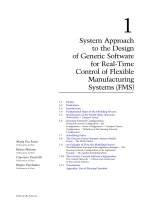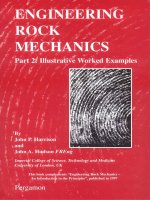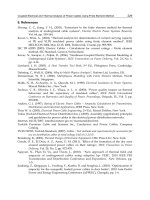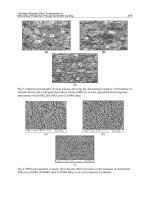Engineering rock mechanicsan volume1 doc
Bạn đang xem bản rút gọn của tài liệu. Xem và tải ngay bản đầy đủ của tài liệu tại đây (11.66 MB, 458 trang )
I.,
.
.
on
i
I
Engineering rock
mechanics
an introduction to
the
principles Engineering
I
0
rock
mechanics
an introduction to the principles
John
A.
Hudson
Professor
of
Engineering
Rock
Mechanics
Imperial College of Science, Technology and Medicine
University
of
London,
UK
and
John
P.
Harrison
Senior Lecturer in Engineering
Rock
Mechanics
Imperial College
of
Science, Technology
and
Medicine
University
of
London,
UK
Pergamon
An
imprint
of
Elsevier Science
Amsterdam
-
Lausanne
-
New York
-
Oxford
-
Shannon
-
Singapore
-
Tokyo
ELSEVIER SCIENCE Ltd
The Boulevard, Langford Lane
Kidlington,
Oxford
OX5
IGB,
UK
0
1997
J.
A.
Hudson and
J.
P.
Harrison. Published by Elsevier Science Ltd.
This work is protected under copyright by Elsevier Science, and the following terms and conditions apply to its use:
Photocopying
Single photocopies of single chapters
may
be made for
personal
use
as
allowed by national Copyright laws. Permission
of the Publisher and payment of a fee is
required
for all other photocopyin& including multiple
or
systematic
copyin&
copying for advertising
or
promotional purposes, resale, and
all
forms of document delivery. Special rates
are
available
for educational institutions that wish to make photocopies for non-profit educational classroom use.
Permissions may
be
sought directly from Elsevier Science Global Rights Department, PO
Box
800, Oxford
OX5
IDX,
UK;
phone:
(+44)
1865 843830, fax: (+44) 1865 853333, e-mail:
You
may also contact
Global Rights directly through Elsevier=s home page
(),
by selecting ‘Obtaining Permissions’.
.
In
the USA, users may clear permissions and make payments through the Copyright Clearance Center, Inc., 222
Rosewood Drive, Danvers,
MA
01923, USA; phone: (978) 7508400, fax: (978) 7504744, and
in
the
UK
through the
Copyright Licensing Agency Rapid Clearance
Service
(CLARCS),
90
Tottenham
Court Road, London WlP
OLP,
UK;
phone: (+44) 171 631
5555;
fax: (+44) 171 631
5500.
Other countries may have a local reprographic
rights
agency
for payments.
Derivative
Works
Tables of contents may be reproduced for internal circulation, but permission of Elsevier Science is required for
external resale
or
distribution of such material.
Permission of the Publisher is required for all
other
derivative works, including compilations and translations.
Electronic Storage
or
Usage
Permission of the Publisher is required to store or use electronically any material contained in this work, including any
chapter or part
of
a chapter.
Except
as
outlined above, no part of this work may be reproduced, stored
in
a retrieval system
or
transmitted
in
any
form or by any means, electronic, mechanical, photocopying, recording or otherwise, without prior written permission
of
the Publisher.
Address permissions requests to: Elsevier Science Global Rights Department,
at
the mail, fax and e-mail
addresses
noted above.
Notice
No
responsibility is assumed by the Publisher for any injury andor damage
to
persons or property
as
a matter of
products liability, negligence or otherwise, or from any use
or
operation of any methods, products, instructions or ideas
contained in the material herein. Because of rapid advances in the medical sciences, in particular, independent
verification
of
diagnoses and drug dosages should be made.
First edition
1997
Second impression
2000
Library of Congress Cataloging in Publication Data
A catalog record from the Library of Congress has been applied for.
British Library Cataloguing in Publication Data
A
catalogue record from the British Library has been applied for.
ISBN:
ISBN:
0
08 04 19 12
7
(Hardbound)
0
08
043864 4 (Flexibound)
The paper used in this publication meets the requirements
of ANSI/NISO
239.48-1992 (Permanence
of
Paper).
Typeset by Gray Publishing, Tunbridge Wells, Kent
Printed and bound in Great Britain by Redwood Books, Trowbridge
For
all
our
past, present and future students and colleagues
at Imperial College
About the authors
Professor
J.
A.
Hudson
John Hudson graduated in 1965 from the Heriot-Watt University and
obtained his Ph.D. in 1970 at the University of Minnesota. He has spent his
professional career in rock mechanics and rock engineering-as they apply
to both civil and mining engineering-in consulting, research and teach-
ing. He has written over 100 scientific papers and been awarded the D.Sc.
degree by the Heriot-Watt University for his contributions to the subject.
From 1983 to 1993, Professor Hudson was based at Imperial College
where most of the book was written. He is now a Principal of Rock Engi-
neering Consultants, a Visiting Professor at Imperial College, and actively
engaged in applying engineering rock mechanics principles to relevant
engineering practice worldwide.
Dr
J.
P.
Harrison
John Harrison graduated in
civil
engineering from Imperial College,
University of London and then worked for some years in the civil engi-
neering industry with both contracting and consulting organizations.
This was interspersed by studies leading to
a
Master’s degree, also from
Imperial College, in engineering rock mechanics. In 1986 he was appoint-
ed Lecturer
in Engineering
Rock Mechanics at Imperial College,
was
promoted to Senior Lecturer in 1996 and now directs undergraduate and
post-graduate rock mechanics teaching, as well as research there.
His personal research interests are in the characterization and behaviour
of discontinuous rock masses and, for his work on novel mathematical
methods applied to the analysis
of
discontinuity geometry, he was awarded
the degree of Ph.D. by the University
of
London in 1993.
Contents
Preface
1.
Introduction
1.1
1.2 Content of this book
The subject of rock mechanics
2.
Geological
setting
2.1
2.2 Natural rock environments
2.3
3.
Stress
3.1 Why study stress in rock mechanics and rock engineering?
3.2 The difference between a scalar, a vector and a tensor
3.3 Normal stress components and shear stress components
3.4 Stress as a point property
3.5 The stress components on a small cube within the rock
3.6 The symmetry of the stress matrix
3.7 The state of stress
at
a
point has six independent components
3.8 The principal stresses
3.9 All unsupported excavation surfaces are principal stress
planes
3.10 Concluding remarks
4.
In
situ
stress
4.1
4.2
4.3 Methods of stress determination
4.4
4.5
4.6
Rock as an engineering material
The influence of geological factors on rocks and rock masses
Why determine
in situ
stress?
Presentation of
in
situ
stress state data
Statistical analysis
of
stress state data
The representative elemental volume for stress
Predictions of natural
in
situ
stress states based
on
elasticity
theory
xi
1
1
9
11
11
14
16
31
31
32
32
33
34
36
37
37
38
40
41
41
41
42
52
54
56
4.7 Collated worldwide
in situ
stress data 59
viii
Contents
4.8
4.9
4.10
Reasons for high horizontal stresses
Effect
of
discontinuities on the proximate
state
of
stress
Glossary of terms related to stress states in rock masses
5.
Strain
5.1
Finite strain
5.2
Examples of homogeneous finite strain
5.3
Infinitesimal strain
5.4
The strain tensor
5.5
The elastic compliance matrix
5.6
6.
Intact rock
6.1
6.2
6.3
6.4
6.5
Failure criteria
6.6
Concluding remarks
7.
Discontinuities
7.1
The occurrence of discontinuities
7.2
Geometrical properties of discontinuities
7.3
Mechanical properties
7.4
Discussion
8.
Rock masses
8.1
Deformability
8.2
Strength
8.3
Post-peak strength behaviour
9.
Permeability
9.1
Fundamental definitions
9.2
Primary and secondary permeability
9.3
Flow through discontinuities
9.4
Flow through discontinuity networks
9.5
Scale effect
9.6
9.7
Implications for
in
situ
stress
The background to intact rock testing
The complete stress-strain curve in uniaxial compression
Soft, stiff and servo-controlled testing machines
Specimen geometry, loading conditions and environmental
effects
A
note on effective stresses
Some practical aspects: grouting and blasting
10.
Anisotropy
and
inhomogeneity
10.1
Definitions
10.2
Anisotropy
10.3
Inhomogeneity
10.4
Ramifications for analysis
11.
Testing techniques
11.1
Access
to the rock
62
65
68
71
71
73
75
77
78
82
85
85
86
89
95
106
111
113
114
116
134
138
141
141
144
147
149
149
151
151
154
156
159
160
163
163
165
166
169
173
173
Contents
ix
11.2
11.3
Tests on intact rock
11.4
Tests on discontinuities
11.5
Tests on rock masses
11.6
Standardized tests
Tailoring testing to engineering requirements
12.
Rock mass classification
12.1
12.2
Q-system
12.3
12.4
12.5
Discussion
12.6
12.7
Concluding remarks
13.
Rock dynamics and time-dependent aspects
13.1
Introduction
13.2
Stress waves
13.3
Time-dependency
13.4
Time-dependency in rock engineering
14.
Rock mechanics interactions and rock engineering
14.1
Introduction to the subject
14.2
Interaction matrices
14.3
14.4
Symmetry
of
interaction matrices
14.5
14.6
14.7
Concluding remarks
15.
Excavation principles
15.1
The excavation process
15.2
Rock blasting
15.3
Specialized blasting techniques
15.4
Mechanical excavation
15.5
Vibrations due to excavation
Rock Mass Rating (RMR) system
Applications
of
rock mass classification systems
Links between the classification systems and rock properties
Extensions to rock mass classification techniques
systems (RES)
Interaction matrices in rock mechanics
A
rock mechanics-rock engineering interaction matrix
Further examples
of
rock mechanics interaction matrices
16.
Stabilization principles
16.1
16.2
The stabilization strategy
16.3
Rock reinforcement
16.4
Rock
support
16.5
16.6
17.
Surface excavation instability mechanisms
17.1
Slope instability
17.2
Foundation instability
The effect
of
excavation on the rock mass environment
Stabilization
of
'transitional' rock masses
Further comments
on
rock stabilization methods
1
74
177
181
186
191
193
193
195
198
201
201
202
206
207
207
208
213
221
223
223
225
228
229
232
235
236
239
239
243
248
255
261
267
267
269
271
274
279
282
287
287
298
x
Contents
18. Design and analysis
of
surface excavations
18.1
Kinematic analysis of slope instability mechanisms
18.2
Combined kinematic analysis of complete excavations
18.3
Foundations: stress distributions beneath variably loaded
areas
18.4
Techniques for incorporating variations
in
rock and site
factors into the analyses
19.
Underground excavation instability mechanisms
19.1
Structurally-controlled instability mechanisms
19.2
Stress-controlled instability mechanisms
19.3
20.
Design and analysis
of
underground excavations
20.1
Design against structurally-controlled instability
20.2
Design against stress-controlled instability
20.3
Integrated design procedures
References
A
note on time-dependency and weathering
Appendix A: Stress and strain analysis
Stress analysis
Strain analysis
Appendix
B:
Hemispherical projection
Hemispherical projection methods
Points to remember
Index
309
309
323
325
330
339
339
346
359
361
361
374
392
393
399
399
411
431
431
439
441
Preface
With the title
Engineering
Rock
Mechanics,
what is this book about? It is about
the discipline, based on mechanics, which is used to design structures built
on or in rock masses. These structures, which encompass building foun-
dations, dams, rock slopes, tunnel, caverns, hydroelectric schemes, mines,
etc., depend critically on the rock mass properties and the interaction
between the rock mass and the engineered structure. As a result, the
distinct discipline of engineering rock mechanics has developed. The term
’rock mechanics’ refers to the basic science of mechanics applied to rocks;
whilst the term ’rock engineering’ refers to any engineering activity
involving rocks. Thus, the term ’engineering rock mechanics’ refers to the
use of rock mechanics in rock engineering-within the context of civil,
mining and petroleum enpeering. Because rock mechanics can also be
used to study structural geology, we emphasize through the title that
it
is
the rock mechanics principles in the engineering context that we are
presenting.
The book is based on the content of the integrated enpeering rock
mechanics course given at Imperial College and on the authors’ engi-
neering experience. Chapters
1-13
cover rock mechanics, Chapter
14
discusses the principles
of
rock engineering systems, and Chapters
15-20
cover major applications in rock engineering. The philosophy
of
the
presentation is to provide comprehension of all the subjects discussed. In
all aspects, and particularly in the mathematics, we have included some
physical explanations of the meaning behind the relations. Also, our
philosophy is that although rock mechanics and the associated principles
are a science, their application is an art.
To
paint a good picture, one must
know the basic techniques. Knowing these techniques will not necessarily
make a good painter, but
it
will optimize everyone’s attempts.
Thus, the book is intended to be an understandable ’across-the-board
source of information for
the
benefit
of
anyone involved
in
rock mechanics
and rock enpeering: students, teachers, researchers, clients, consulting
engineers and contractors.
It
will be of particular use in the civil, mining
and petroleum subject areas: the objectives of the engmeering may be
different but the principles are the same.
xii
Preface
We hope that everyone reading this book not only has a chance to experi-
ence the science and art of the subject, but also the romance.
Rock
engi-
neering occurs deep in the earth, high in the mountains and often in the
worlds wildest places. We engineer with rocks as we create structures,
extract the primary raw materials for mankind and harness the forces
of
nature. It
is
the romance and the passion associated with
rock
engineering
that has led us to communicate some of this excitement. ’Personal
experience’
is
everything.
So,
we hope that you will have the opportunity
to experience at first hand some of the principles and applications described
in the book.
Lecture notes prepared by the authors for undergraduate and post-
graduate students at Imperial College were the basis for the book. Some
of
the material, especially that
of
a fundamental nature, is partially based on
earlier lecture notes prepared by our predecessors
in
the rock mechanics
section at the college. We acknowledge
this
general debt with thanks and
appreciation. We are also grateful to all our students and recent colleagues
at Imperial College who have suggested improvements to the text during
the pre-publication ‘field-testing’ period over the last few years. Finally, we
thank Carol and Miles Hudson and Gwen Hamson for painstakingly
correcting and compiling the penultimate version. The final text
is,
of
course, our responsibility: if there is anything in the foIlowing pages that
you
do
not understand, it is
our
fault.
J.
A.
Hudson and
J.
P.
Hamson
Imperial College
of
Science, Technology
and
Medicine
University
of
London
7
Introduction
1.1
The
subject
of
rock
mechanics
The subject of rock mechanics started in the
1950s
from a rock physics base
and gradually became a discipline in its own right during the
1960s.
As
explained in the Preface, rock mechanics is the subject concerned with the
response of rock to an applied disturbance, which is considered here
as
an
engineering, i.e. a man-induced, disturbance. For a natural disturbance,
rock mechanics would apply to the deformation of rocks in a structural
geology context, i.e. how the folds, faults, and fractures developed as
stresses were applied to the rocks during orogenic and other geological pro-
cesses. However, in this book we will be concerned with rock mechanics
applied
to
engineering for civil, mining, and petroleum purposes.
Thus, rock mechanics may be applied to many engineering applications
ranging from dam abutments, to nuclear power station foundations, to the
manifold methods of mining ore and aggregate materials, to the stability
of
petroleum wellbores and including newer applications such as
geothermal energy and radioactive waste disposal. Probably, the main
factor that distinguishes rock mechanics from other engineering disciplines
is
the application
of
mechanics on
a
large scale to a pre-stressed, naturally
occurring material.
In the two photographs in Figs
1.1
and
1.2,
we illustrate a typical full-
scale rock structure and a closer view of the rock material itself. It is quite
clear from these illustrations that the nature
of
the rock mass and the rock
material must be taken into account in both the basic mechanics and the
applied engineering. This has been increasingly appreciated since the
beginning of the discipline in the early
1960s.
In the civil and mining engineering areas, the subject of rock mechanics
flourished in the
1960s.
In
1963,
a particular landmark was the formation
of the International Society for Rock Mechanics which has grown steadily
to its current membership of about
7000
from
37
countries. The discipline
of rock mechanics
is
universal in its application and the engineering is
especially visible in those countries where the ground surface
is
predomi-
nantly composed
of
rock, for example, Chile, Finland, Scotland, Spain, and
2
Introduction
Figure
1.1
Rock structure illustrating the complex nature
of
the material.
the former Yugoslavia. In these and other similar 'rocky' countries, rock
engineering is a way of life for civil engineering construction: invariably,
Figure
1.2
A
closer view
of
the breaks in the mechanical continuum, generically
termed discontinuities.
The subject
of
rock mechanics
3
Figure
1.3
Example of
a
bulk blast for
production
purposes
in
a quarry.
highways and other features will have been blasted in rock. The
two
photographs in Figs
1.3
and
1.4
demonstrate this type of engineering.
Naturally, there are many examples
of
rock engineering underground
and these occur in civil engineering projects in rock-dominated countries
and during underground mining in all countries. The ubiquitous road and
railway tunnels can have quite different appearances depending on the
engineering and architectural finish. In the
two
photographs in Figs
1.5
and
1.6,
the contrast is shown between a tunnel that required no lining
so
the
bare rock is visible and a tunnel that required extensive support.
There are often occasions when small or large surface excavations are
Figure
1.4
Example of a
rock
face made by pre-split blasting to give a stable,
relatively
smooth
finish.
4
Introduction
Figure
1.5
Unlined tunnel excavated by a tunnel boring machine (tunnel face to
left, tunnel wall to right
of
photograph).
made in rock. Clearly, it is helpful to be able to evaluate the stability of the
excavation-whatever size it may be. This highlights another crucial aspect
which has only really been developed since the 1970s, and that is
understanding the full role of the rock structure, i.e. not only the intact rock
but also the rock fractures and their three-dimensional configuration. In
general, the stability of near surface excavations is governed by the rock
structure, whereas, deeper excavations can be more affected by the intact
rock and pre-existing stresses.
Thus, the rock structure is particularly important in
civil
engineering and
open-pit mines and
so
it is necessary to be able to characterize and understand
the mechanics of a discontinuum.
This
is well illustrated by the
two
pho-
tographs
in
Figs 1.7 and
1.8,
the first showing how individual rock blocks are
formed and the second showing a large open-pit mine with some instabilities.
In fact, there are numerous applications for rock engineering and three
are illustrated in Figs 1.9-1.11. Some of the most important are dam
abutments and foundations, mining methods (whether as open-pit or as a
whole variety of underground techniques) and now non-precedent
applications for which there is no previous experience to guide
us.
These
latter projects include geothermal energy, radioactive waste disposal and
the general use of underground space for hosting a miscellany of low- and
high-technology activities, such as domestic refuse treatment and large
The
sub+
of
rock mechanics
5
Figure
1.6
Heavily supported tunnel excavated by blasting.
high-energy particle accelerators.
For
all
of
these applications, it is essen-
tial to understand the rock material and the rock mechanics
so
that
engineering can be conducted in an optimal way.
Figure
1.7
Rock fractures forming rock blocks within the rock structure (with
1
m long white scale).
6
introduction
Figure
1.8
Open-pit
mine
with
slope instabilities.
The three photographs in Figs
1.9-1.11
also illustrate the large scale of
some of the existing precedent practice projects: a dam, a mine, and a civil
excavation. It is apparent from the pictures that there will be considerable
economic benefit in designing and constructing these structures in the
optimal way-given that we have the necessary rock mechanics principles
and rock engineering experience. It is also evident that one ignores such
information at considerable physical and financial peril.
A
good engineer
is one who can do the same job with the same professionalism at a lower
price: but this can only be achieved successfully by knowing the rock
mechanics principles and applications.
Figure
1.9
Large
dam
in
Portugal.
The subject
of
rock mechanics
7
Figure
1.10
Large open-pit mine in Chile.
All these rock engineering projects, whether we have experience of them
or not, can be summarized in the diagram
in
Fig.
1.12.
In this diagram, there
is appreciation of the three main aspects of such engineering projects:
the outer ring represents the whole project complete with its specific
objective-and different projects can have widely differing objectives.
the middle ring represents the inter-relation between the various
components of the total problem. For example, there will be relations
Figure
1.11
Hydroelectric cavern in Portugal.
8
Introduction
\
7
Analysis
of
individual subjects
7
Foundation
444
1
I
7
/-Analysis
of
coupled mechanisms
Rock mechanics interaction matrices
-
e.g.
block
analysis
or
stress
analysis
3
7
/=Complete
rock
engineering problems
LKnowledge-based expert systems
/
,,,,
edi'
II
shaft
A
$3
Borehole/
Underground
excavation
r'
+
xs\%G'
/E$'''-
9
+
Boundary
conditions:
+
In
siru
stress,
hydrogeological regime
Figure
1.12
Three-tier approach
to
all rock engineering problems.
between rock stresses and rock structure in the rock mechanics context;
and there will be relations between rock support systems and cost
implications
in
the rock engineering context.
finally, the central ring represents the individual aspects
of
each project,
such as a specific numerical analysis or a specific costing procedure.
In the spirit
of
this diagram, we discuss the major rock mechanics aspects
on an individual basis in Chapters
2-13.
The method of studying the
interactions between subjects
is
discussed in Chapter
14.
Then,
in
Chapters
15-20,
the main engineering techniques and applications are
discussed. In engineering practice, the procedure is to enter the diagram
in Fig.
1.12
from the outside having specified the objective, pass through
the three rings conducting the necessary analyses at each stage, and then
exit synthesizing the most appropriate design.
We have already mentioned that in rock mechanics there was
considerable emphasis in the
1960s
on intact rock and
in
the
1970s
on
discontinuities and rock masses. In the
1980s
the emphasis shifted to
numerical analysis and we anticipate that, during the remaining part
of
the
1990s
and beyond, there
will
be combined emphases on material property
determination, full-scale
in
situ
experiments, enhanced use of the
computer, and improved engineering implementation
of
the principles.
Currently, our ability to compute has far outstripped our ability to measure
the required input parameters and indeed to know whether the computer
modelling is realistic.
A
good example
of
this is the theory
of
elasticity
which considers stresses and strains
in
the rock. The
vast
majority
of
elasticity analyses have assumed that the rock is isotropic, i.e. it has the
same elastic properties in all directions, which requires two elastic
properties. We now recognize that it
is
more realistic to include further
elastic properties, five elastic constants for transverse isotropy (the
Content
of
th;s
book
9
properties are the same
in
a plane but different perpendicular to that plane)
and nine elastic constants for the orthotropic case (where the properties are
different
in
three perpendicular directions). However, for a fully
anisotropic rock,
21
such constants are needed. To the authors’ knowledge,
these
21
constants have never been used in a numerical analysis and
certainly have never been measured in a rock engineering project.
Establishing the balance between not including enough rock property
information and conducting unnecessarily complex analyses is difficult but
made much easier if the engineering rock mechanics principles are
understood.
Generalizing the problem described above, one should ask ‘What exactly
is
it that we wish to know for the design of engineering projects?’ In this
book, we consider both the principles and the applications and we have
included discussions which address the question above and will assist in
the design process.
1.2
Content
of
this
book
This book is intended for anyone involved in rock mechanics and rock
engineering. From the text
in
the previous section, the reader will have
noted that we are making a special attempt to present the principles and
then to place them in the engineering context. Thus, the book can be used
for both introductory and advanced rock mechanics teaching, and by rock
engineers of all persuasions. We feel that the rock mechanics subject does
not have to be project-specific and can therefore be generally directed to
all types of engineers working on or in rock masses.
The layout follows a logical course from chapters on the basic subjects
of rock mechanics such as stress, strain, discontinuities and permeability
through the generic rock engineering aspects
of
excavation and support to
specific engineering objectives and projects in the later chapters.
Anyone who has worked in rock engineering will know that all projects
have their own idiosyncratic components and are unique. Thus, whether
an engineer is involved with a conventional or an unconventional project,
it is always vital to understand and apply the principles presented in the
first
13
chapters.
This book
is
about the
principles
of engineering rock mechanics. The
book is not intended to be truly comprehensive in the sense
of
including
all information on the rock engineering subject. Readers requiring more
information are referred to the five volume compendium
Comprehensive
Rock
Engineering,
edited by the first author and also published by Elsevier.
Geological setting
2
In this chapter, we will set the scene for the consideration of engineering
in the natural material, rock. Most
of
our engmeering materials (with the
exception of timbers and soil) are manufactured and tested to specification.
Subject to correct quality control, we can then be sure that the engineering
material in question has a given set of properties which are used in the
design process. However, rock is extremely
old
compared to all other
engineering materials: its age is measured in millions
of
years and it has
undergone significant mechanical, thermal and chemical activity.
We
will describe in the following sections the ramifications of the rocks
history for engineering, starting with rock as an engineering material and
following with a discussion
of
the conditions in natural rock environments.
In Section
2.3,
we will discuss explicity the influence
of
geological history
on five
of
the most important aspects of rock mechanics; and, later on, we
will explain more directly (in the context of stresses and strains) the
concepts of continuity, homogeneity and isotropy
of
rock material and rock
masses.
2.1
Rock
as an engineering material
One of the most important, and often frequently neglected, aspects of rock
mechanics and rock engneering is that we are utilizing an existing material
which is usually highly variable. This is demonstrated in Figs
2.1-2.3.
The
rock will be used either as a building material
so
the structure will be made
of
rock, or a structure will be built
on
the rock, or a structure will be built
in
the rock. In the majority
of
civil engineering cases, rock is removed to
form the structure
as
in,
for
example, the excavation of rock for a
hydroelectric machine hall chamber. In this sense, we are dealing with a
reverse type of construction where the rock material is being taken away,
rather than added, to form a structure. On the mining side, rock may be
excavated in an open pit and we will then be concerned with the stability
of
the sides of the open pit.
In
these examples and all others in rock engineering, the material is
natural.
As
engineers and in the context
of
mechanics, we must establish
12
Geological sefting
Figure
2.1
Relatively
consistent intact rock.
Figure
2.2
'Layered'
intact rock.









